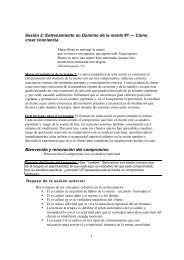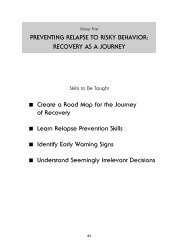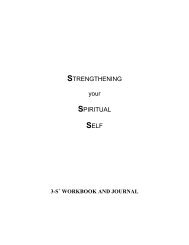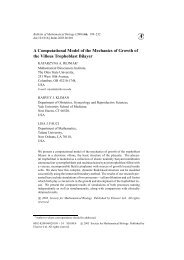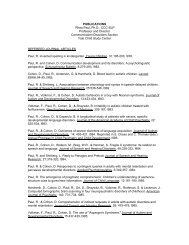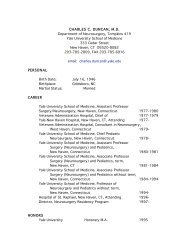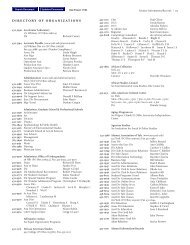The Spiritual Self Schema (3-S) Development Program
The Spiritual Self Schema (3-S) Development Program
The Spiritual Self Schema (3-S) Development Program
Create successful ePaper yourself
Turn your PDF publications into a flip-book with our unique Google optimized e-Paper software.
patterns of thinking, feeling, and behaving as they actually occur in<br />
your daily life. However, this process requires commitment and diligent<br />
practice.<br />
This step is extremely important not only because it will help you<br />
become more aware of the different self-schemas that are habitually<br />
activated in your daily life, but also because monitoring habitual selfschemas,<br />
as they occur, helps to interrupt their automaticity, which can<br />
provide you with the opportunity to turn off the "automatic pilot" and<br />
interject conscious choice. As described below, you will observe the<br />
automaticity of these self-schemas and their dependence on context,<br />
and you will determine the extent to which you are able to experience<br />
and express your <strong>Spiritual</strong> nature when they are activated.<br />
You will be stopping very briefly three times each day simply to<br />
identify the habitual "path" (the self-schema) that you are currently<br />
accessing. We call this a <strong>Self</strong>-<strong>Schema</strong> Check-In. Before you begin, it is<br />
important to identify the most convenient time to do your check-in<br />
consistently, and to create at least two different "cues-to-action" (i.e.,<br />
such as beepers, meal times, post-it notes in conspicuous places, and so<br />
forth) to remind you to stop and check-in with yourself.<br />
Rehearse (practice) and Record.<br />
Three times each day for the next week, STOP whatever<br />
you are doing and conduct a <strong>Self</strong>-<strong>Schema</strong> Check-In.<br />
A self-schema check-in is rather like stopping to check your map<br />
periodically while traveling on a complicated highway system to make<br />
sure you are going the right way. What you will be doing when you<br />
stop three times a day will be to identify the habitual self-schema that<br />
was active just before you stopped -- in other words, what "path" were<br />
you taking and where was it taking you?<br />
Once you have identified the self-schema that was active before<br />
you stopped, give it a brief descriptive name (for example, it may be<br />
your professional identity, or your role as parent, spouse, friend,<br />
caregiver, or patient, or it may be a habitual thought or behavioral<br />
22



